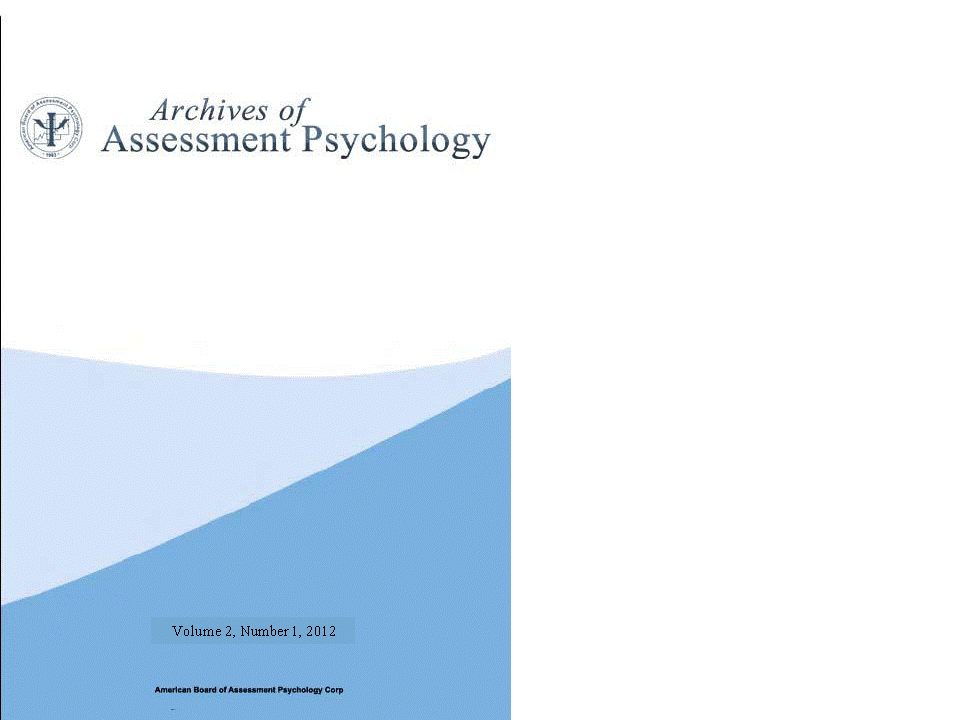Does Memory Predict Decline in Activities of Daily Living in Older Adults with Alzheimer's Disease?
Abstract
As the prevalence of Alzheimer’s disease (AD) increases, neuropsychologists will need to make accurate recommendations regarding cognitive and functional decline in these individuals. Since memory impairment is the hallmark of AD, this study examined whether auditory and visual memory could significantly predict deficits in self-care activities. Participants were older adults diagnosed with AD, who received a neuropsychological battery assessing their functional decline and memory. Of auditory memory measures, immediate auditory memory was significantly correlated with declines financial and medication management; none of the auditory memory measures were significantly correlated with declines in driving, dressing, grooming, or feeding abilities. Of the visual-spatial memory measures, the Rey Complex Figure Test (RCFT) was significantly correlated with declines in financial management, and RCFT and immediate visual memory were significantly correlated with declines in medication management. The RCFT and delayed visual memory were significantly correlated with declines in driving and dressing abilities. None of visual-spatial measures were significantly correlated with declines in grooming or feeding. The results indicated that different patterns in memory impairments can be used to predict declines in different self care activities.References
Avila, R., Bottino, C. M. C., Carvalho, I. A. M., Santos, C. B., Seral, C., & Miotto, E. C. (2004). Neuropsychological rehabilitation of memory deficits and activities of daily living in patients with Alzheimer’s disease: A pilot study. Brazilian Journal of Medical and Biological Research, 37, 1721-1729. doi:10.1590/S0100-879X2004001100018
Binetti, G., Locascio, J. J., Corkin, S., Vonsattel, J. P., & Growdon, J. H. (2000). Differences between Pick disease and Alzheimer disease in clinical appearance and rate of cognitive decline. Archives of Neurology, 57, 225-232. Retrieved from http://ovidsp.tx.ovid.com.ezproxylocal.library.nova.edu/sp-2.3.1b/ovidweb.cgi?
Boyle, P. A., Malloy, P. F., Salloway, S., Cahn-Weiner, D., Cohen, R., & Cummings, J. L. (2003). Executive dysfunction and apathy predict functional impairment in Alzheimer’s disease. The American Journal of Geriatric Psychiatry, 11, 214-221. Retrieved from http://proquest.umi.com.ezproxylocal.library.nova.edu/pqdlink?Ver=1&Exp=05-22-2015&FMT=7&DID=302645831&RQT=309&cfc=1
Bucks, R. S., Ashworth, D. L., Wilcock, G. K., & Siegfried, K. (1996). Assessment of activities of daily living in dementia: Developoment of the Bristol Activities of Daily Living Scale. Age and Ageing, 25, 11-120. Retrieved from http://ageing.oxfordjournals.org/cgi/reprint/25/2/113.pdf
Cahn-Weiner, D. A., Boyle, P. A., & Malloy, P. E. (2003). Tests of executive function predict instrumental activities of daily living in community-dwelling older individuals. Applied Neuropsychology, 9, 187-191. doi:10.1207/S15324826AN0903_8
Cahn-Weiner, D. A., Farias, S. T., Julian, L., Harvey, D. J., Kramer, J. H., Reed, B. R., Mungas, D., Wetzel, M., & Chui, H. (2007). Cognitive and neuroimaging predictors of instrumental activities of daily living. Journal of the International Neuropsychological Society, 13, 747-757. doi:10.10170S1355617707070853
Davous, P., Panisset, M., De Agostini, M., & Boller, F. (1996). Visuo-spatial dysgnosia and Balint’s syndrome as major symptoms of probable Alzheimer’s disease. European Journal of Neurology, 3, 519-527. Retrieved from http://csaweb112v.csa.com.ezproxylocal.library.nova.edu/ids70/view_record.php?id=13&recnum=0&log=from_res&SID=8ioekj8r19j0hv3e37sqrg6ge7&mark_id=search%3A13%3A81%2C0%2C1
Farias, S. T., Harrell, E., Neumann, C., & Houtz, A. (2002). The relationship between neuropsychological performance and daily functioning in individuals with Alzheimer’s disease: Ecological validity of neuropsychological tests. Archives of Clinical Neuropsychology, 18, 655-672. doi:10.1016/S0887-6177(02)00159-2
Ganguli, M., Rodriguez, E., Mulsant, B., Richards, S., Pandav, R., Bilt, J. V., Dodge, h. H., Stoehr, G. P., Saxton, J., Morycz, R. K., Rubin, R. T., Farkas, B., & DeKosky, S. T. (2004). Detection and management of cognitive impairment in primary care: The steel valley senior survey. Cognitive Impairment in Primary Care, 52, 1668-1675. doi:10.1111/j.1532-5415.2004.52459.x
Hemphill, R. E., & Klein, R. (1998). Contribution to the dressing disability as a focal sign and to the imperception phenomenon. Journal of Mental Science, 94, 611-622. Retrieved from http://csaweb112v.csa.com.ezproxylocal.library.nova.edu/ids70/view_record.php?id=20&recnum=0&log=from_res&SID=8ioekj8r19j0hv3e37sqrg6ge7&mark_id=search%3A20%3A109%2C0%2C1
Jefferson, A. L., Barakat, L. P., Paul, R. H., & Glosser, G. (2006). Object perception impairments predict instrumental activities of daily living dependence in Alzheimer’s disease. Journal of Clinical and Experimental Neuropsychology, 28, 884-897. doi:10.1080/13803390591001034
Kurz, X., Scuvee-Moreau, J., Rive, B., & Dresse, A. (2003). A new approach to the qualitative evaluation of functional disability in dementia. International Journal of Geriatric Psychiatry, 18, 1050-1055. doi:10.1002/gps.1009
Lezak, M. D., Howieson, D. B., & Loring, D.W. (2004). Neuropsychological Assessment, Fourth Edition (4 ed.). New York: Oxford University Press.
Lowenstein, D. A., Rubert, M. P., Berkowitz-Zimmer, N., Guterman, Z., Morgan, R., & Hayden, S. (1992). Neuropsychological test performance and prediction of functional capacities in dementia. Behavior, Health, and Aging, 2, 149-158. Retrieved from http://csaweb112v.csa.com.ezproxylocal.library.nova.edu
Mahurin, R. K., DeBettignies, B. H., & Pirozzolo, F. J. (1991). Structured assessment of independent living skills: Preliminary report of a performance measure of functional abilities in dementia. Journal of Gerontology, 46, 58-66. Retrieved from http://proquest.umi.com.ezproxylocal.library.nova.edu/pqdlink?Ver=1&Exp=05-22-2015&FMT=7&DID=1887306&RQT=309
McCue, M., Rogers, J. C., Goldstein, G., (1990). Relationships between neuropsychological and functional assessment in elderly neuropsychiatric patients. Rehabilitation Psychology, 35, 91-99. doi:10.1037/h0079052
Nourhashemi, F., Ousset, P. J., Gillette-Guyonnet, S., Canetet, C., Andrieu, S., & Vellas, B. (2008). A 2-year follow-up of 233 very mild (CDR 0.5) Alzheimer’s disease patients (REAL ER cohort). International Journal of Geriatric Psychiatry, 23, 460-465. doi:10.1002/gps.1904
Razani, J., Casas, R., Wong, J. T., Lu, P., Alessi, C., & Josephson, K. (2007). Relationship between executive functioning and activities of daily living in patients with relatively mild dementia. Applied Neuropsychology, 14, 208-214. Retrieved from http://web.ebscohost.com.ezproxylocal.library.nova.edu/ehost/detail?vid=1&hid=111&sid=6e35639d-e3f5-4821-819a-c9e6dff06469%40sessionmgr110&bdata=JnNpdGU9ZWhvc3QtbGl2ZQ%3d%3d#db=byh&AN=26521007
Richardson, E. D., Nadler, J. D., & Malloy, P. F. (1995). Neuropsychologic prediction of performance measures of daily living skills in geriatric patients. Neuropsychology, 9, 565-572. doi:10.1037/0894-4105.9.4.565
Searight, H. R., Dunn, E. J., Grisso, T., Margolis R. B., & Gibbons, J. L. (1989). The relation of the Halstead-Reitan neuropsychological battery to ratings of everyday functioning in a geriatric sample, Neuropsychology, 3, 135-145. doi:10.1037/h0091770
Sikkes, S. A. M., de Lange-de Kler, E. S. M., Pijnenburg, Y. A. L., Scheltens, P., & Uitdehaag, B. M. J. (2009). A systematic review of instrumental activities of daily living scales in dementia: Room for improvement. Journal of Neurology, Neurosurgery, and Psychiatry, 80, 7-12. doi:10.1136/jnnp.2008.155838
Zank, S., & Frank, S. (2002). Family and professional caregivers’ ratings of dementia symptoms and activities of daily living of day care patients: Do differences change over time?. Aging and Mental Health, 6, 161-165. doi:10.1080/13607860220126790

